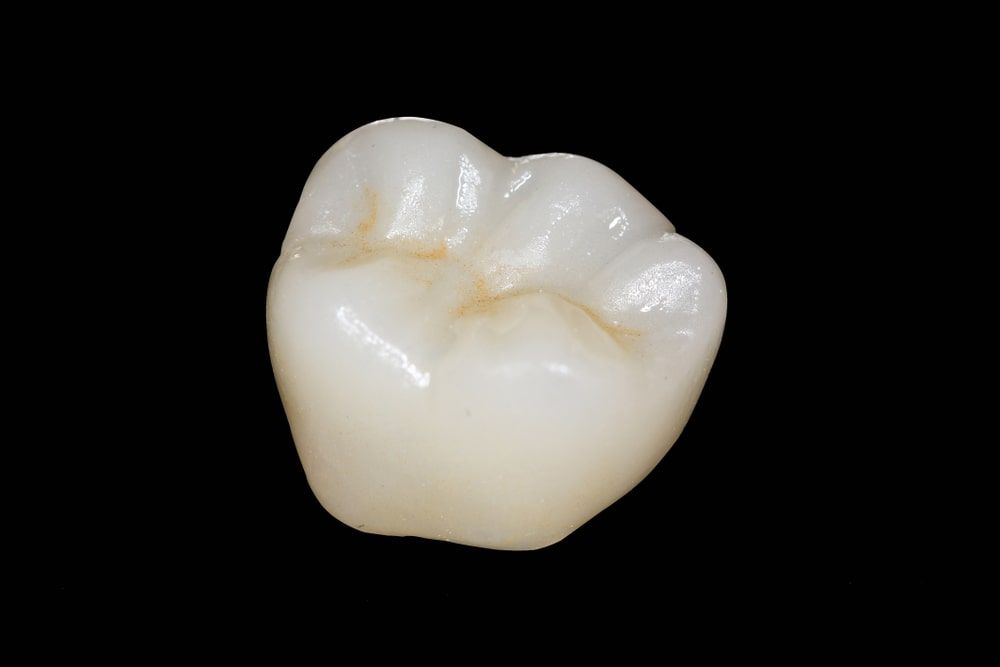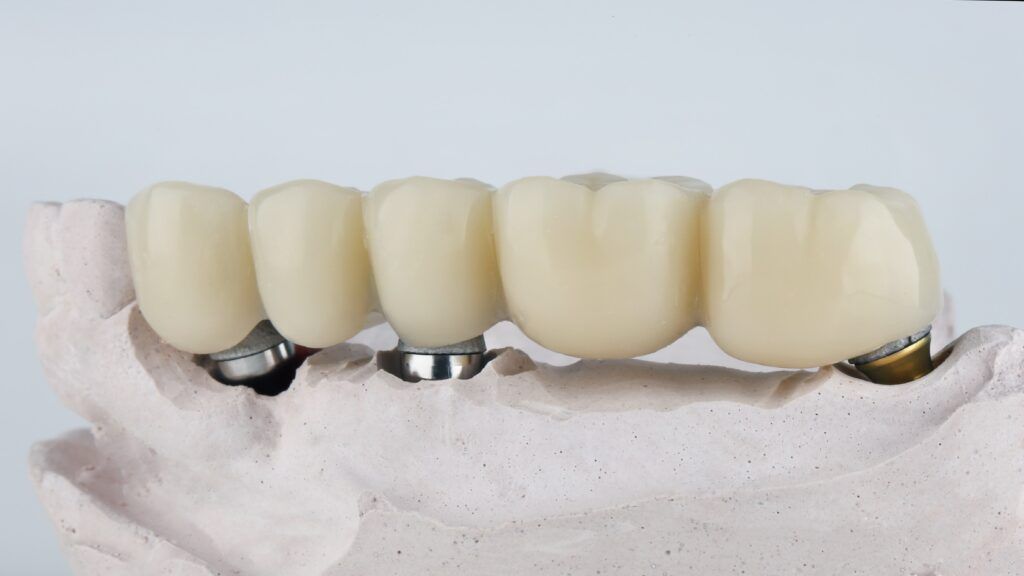Dental implants have revolutionized the field of dentistry, offering a durable and natural-looking solution for replacing missing teeth. At the heart of implant dentistry are crowns and bridges, essential components that not only restore dental function but also enhance aesthetics. In this blog, we delve into the intricacies of crowns and bridges in dental implants, exploring their roles, benefits, challenges, and future trends. Whether you’re considering dental implants for yourself or seeking to expand your knowledge in implant dentistry, this guide aims to shed light on the vital role that crowns and bridges play in bridging the gap between tooth loss and a confident, functional smile.
In This Blog:
- Understanding Crowns and Bridges
- The Role of Crowns in Dental Implants
- The Role of Bridges in Dental Implants
- Comparing Crowns and Bridges in Dental Implants
Understanding Crowns and Bridges

In the realm of implant dentistry, understanding the nuances of crowns and bridges is fundamental. These prosthetic devices serve as crucial components in restoring both the functionality and aesthetics of a patient’s smile.
- Crowns: Crowns, also known as caps, are custom-made tooth-shaped restorations that are placed over a dental implant or a natural tooth. They are designed to mimic the shape, size, and color of a natural tooth, providing strength, stability, and a seamless appearance.
- Bridges: Bridges, on the other hand, are prosthetic devices used to replace one or more missing teeth. In implant dentistry, bridges can be supported by dental implants or adjacent natural teeth, depending on the patient’s specific needs.
Benefits of Crowns and Bridges in Implant Dentistry
The utilization of crowns and bridges in implant dentistry offers a myriad of benefits for patients:
- Restoration of Functionality: Crowns and bridges restore the ability to bite, chew, and speak comfortably, enhancing the overall oral function.
- Aesthetic Enhancement: These prosthetic devices blend seamlessly with natural teeth, improving the smile’s appearance and boosting confidence.
- Preservation of Bone Structure: Implant-supported crowns and bridges help preserve the jawbone by stimulating bone growth, preventing bone loss commonly associated with tooth loss.
- Longevity: With proper care and maintenance, crowns and bridges can last for many years, providing a durable and reliable solution for tooth replacement.
By understanding the role and benefits of crowns and bridges in implant dentistry, patients can make informed decisions about their dental care and enjoy the benefits of a healthy, functional smile.
The Role of Crowns in Dental Implants
Crowns play a pivotal role in dental implants, serving as the visible, functional component that completes the restoration process. Understanding the specifics of crowns in implant dentistry is essential for both patients and dental professionals alike.
Purpose of Crowns in Implant Dentistry
The primary purpose of crowns in dental implants is to mimic the natural appearance and function of a tooth. When a dental implant is placed and integrated into the jawbone, a crown is then attached to the implant abutment, creating a stable and aesthetically pleasing replacement tooth.
Materials Used for Crowns in Dental Implants
Various materials are utilized for crafting crowns in implant dentistry, each offering distinct advantages:

- Ceramic Crowns: Known for their excellent aesthetics and biocompatibility, ceramic crowns closely resemble natural teeth in color and translucency, making them an ideal choice for implant-supported restorations.
- Porcelain-Fused-to-Metal (PFM) Crowns: PFM crowns combine the strength of metal with the aesthetic appeal of porcelain. They provide durability and are suitable for posterior teeth that endure significant biting forces.
- Zirconia Crowns: Zirconia crowns are highly durable and resistant to chipping and staining. They offer exceptional strength, making them suitable for both anterior and posterior implant-supported crowns.
Process of Placing Crowns on Dental Implants
The process of placing crowns on dental implants involves several steps:
- Implant Integration: After the dental implant is surgically placed and osseointegrates with the jawbone, the implant abutment is attached to the implant fixture.
- Impression Taking: An impression of the implant and surrounding teeth is taken to create a custom-made crown that fits seamlessly into the patient’s smile.
- Crown Fabrication: Using advanced dental technology, such as CAD/CAM systems, the crown is fabricated to precise specifications, ensuring optimal fit and aesthetics.
- Final Placement: Once the crown is ready, it is securely placed and attached to the implant abutment, completing the restoration.
Maintenance and Care Tips for Implant-Supported Crowns
Proper maintenance and care are essential for ensuring the longevity of implant-supported crowns:
- Regular Oral Hygiene: Brushing twice a day and flossing daily are crucial for maintaining oral health and preventing plaque buildup around the implant crown.
- Routine Dental Checkups: Regular visits to the dentist allow for professional cleaning, examination of the implant, and early detection of any issues.
- Avoidance of Hard Foods: Patients should avoid chewing on hard foods or using their teeth as tools to prevent damage to the implant crown.
- Use of Recommended Oral Care Products: Dentists may recommend specific oral care products, such as non-abrasive toothpaste and interdental cleaners, for cleaning implant-supported crowns effectively.
By understanding the role, materials, placement process, and maintenance tips for implant-supported crowns, patients can maintain optimal oral health and enjoy the benefits of a functional and natural-looking smile.
The Role of Bridges in Dental Implants
In the realm of implant dentistry, bridges play a crucial role in restoring multiple missing teeth and bridging the gap between adjacent natural teeth or dental implants. Understanding the role and types of bridges used in dental implants is essential for comprehensive patient care.
Purpose of Bridges in Implant Dentistry
Bridges are utilized in implant dentistry to replace one or more missing teeth, providing functional and aesthetic benefits:

- Restoration of Chewing Function: Bridges restore the ability to chew and bite effectively, improving the overall functionality of the dental arch.
- Support for Adjacent Teeth: Implant-supported bridges distribute chewing forces evenly, preventing excessive stress on adjacent natural teeth and supporting oral health.
- Aesthetic Enhancement: Bridges blend seamlessly with natural teeth or implant-supported crowns, enhancing the smile’s appearance and symmetry.
Types of Bridges Used in Dental Implantology
- Traditional Bridges: Traditional bridges consist of pontic(s) (artificial teeth) suspended between two dental crowns. These crowns are typically placed on adjacent natural teeth, serving as anchor points for the bridge.
- Implant-Supported Bridges: Implant-supported bridges are anchored to dental implants rather than natural teeth. This type of bridge offers greater stability, durability, and preservation of adjacent teeth.
Considerations for Bridge Placement and Maintenance
When considering bridges in implant dentistry, several factors should be taken into account:
- Implant Placement: Proper implant placement and integration are crucial for the success of implant-supported bridges.
- Bridge Design: The design of the bridge, including materials and aesthetics, should be tailored to the patient’s specific needs and preferences.
- Oral Hygiene: Patients must maintain good oral hygiene, including regular brushing, flossing, and professional dental cleanings, to ensure the longevity of implant-supported bridges.
- Follow-Up Care: Routine follow-up visits with the dentist allow for monitoring the health of the implants and bridges and addressing any issues promptly.
By understanding the role, types, and considerations for bridge placement and maintenance in implant dentistry, patients can make informed decisions about their dental care and enjoy the benefits of a functional and aesthetically pleasing smile.
Comparing Crowns and Bridges in Dental Implants
In implant dentistry, both crowns and bridges play vital roles in restoring dental function and aesthetics. Understanding the differences and considerations between crowns and bridges can help patients and dental professionals make informed decisions about treatment options.
Pros and Cons of Using Crowns in Implant Dentistry
| Pros of Crowns | Cons of Crowns |
| Natural Appearance | Limited for Multiple Teeth Replacement |
| Individual Tooth Restoration | Maintenance Challenges |
| Preservation of Adjacent Teeth |
Pros and Cons of Using Bridges in Implant Dentistry
| Pros of Bridges | Cons of Bridges |
| Multiple Teeth Replacement | Dependency on Adjacent Teeth or Implants |
| Stability and Durability | Maintenance Challenges |
Factors Influencing the Choice Between Crowns and Bridges
Several factors influence the choice between crowns and bridges in implant dentistry:
- Number of Missing Teeth: The number of missing teeth and their location in the dental arch determine whether crowns or bridges are more suitable.
- Implant Placement: The location and positioning of dental implants play a role in determining the feasibility of placing crowns or bridges.
- Patient Preferences: Patient preferences regarding aesthetics, functionality, and long-term maintenance also influence the choice between crowns and bridges.
By comparing the pros and cons of using crowns and bridges in implant dentistry and considering the factors influencing the choice between the two options, patients and dental professionals can collaborate to determine the most appropriate treatment plan for achieving optimal oral health and aesthetics.
Conclusion
In conclusion, crowns and bridges play indispensable roles in the field of implant dentistry, offering patients effective solutions for restoring dental function and aesthetics. Crowns excel in individual tooth restoration, providing a natural appearance and preserving adjacent teeth. On the other hand, bridges are advantageous for replacing multiple missing teeth, offering stability and durability. Both options have their pros and cons, and the choice between crowns and bridges depends on factors such as the number of missing teeth, implant placement, and patient preferences. By understanding the benefits and considerations of crowns and bridges in implant dentistry, patients can work with their dental professionals to achieve optimal oral health and a confident smile.

